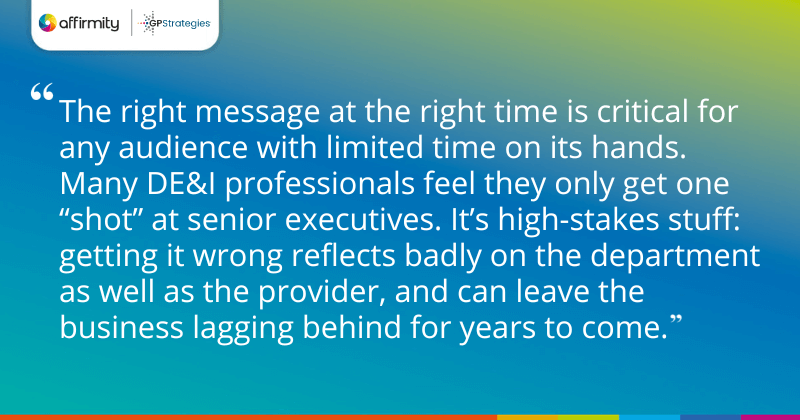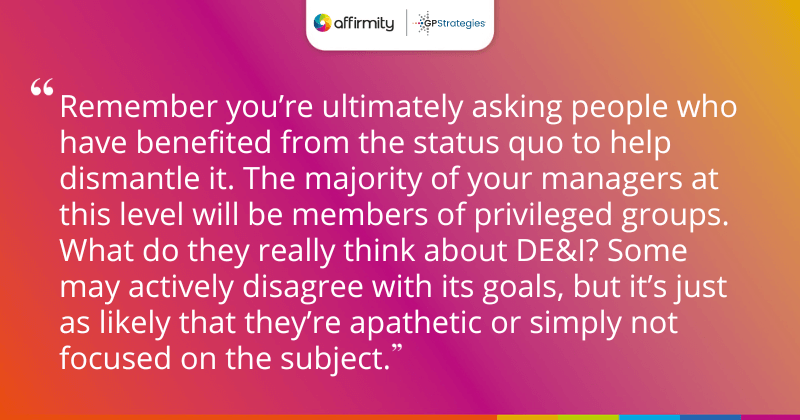Great inclusion training can still fall flat if it’s delivered to the wrong people. In this article, Angela Peacock—Director of Global Diversity and Inclusion at GP Strategies (an Affirmity inclusion training partner)—examines some of the ways that training should be adjusted to the needs of different levels of your organization.
We’re often asked if we would put a group of senior executives through our inclusion escape room workshop. The answer is always the same: “it depends”.
It depends on where your organization is on its journey, and it depends on where your executives are on theirs. While many executive teams know exactly the right things to say when it comes to diversity and inclusion, whether they actually mean those words, or indeed whether they actually get what they’re saying, is another matter entirely.
Providing the right message at the right time is critical for any audience with limited time on its hands. We hear from many DE&I professionals who feel they only get one “shot” at passing on any training experience to senior executives. It’s high-stakes stuff: getting it wrong reflects badly on the department as well as the provider, and can leave the business lagging behind for years to come.
Strategy Is Everything for Leadership: DE&I Needs a Plan of Attack Too
Of course, it isn’t always especially clear where an executive team is on their journey—and some teams may not be comfortable asking senior figures difficult questions on these topics. This is where bringing in DE&I specialists from outside your business to guide conversations really pays off. We’re not afraid to tread on anyone’s toes (though we promise we won’t bite!) and bring an outside perspective that can help you really cut through the talk, and talk more directly about action.

Teams that may have resisted questioning from inside the organization are more likely to be engaged by an outsider—especially when that outsider has a wider perspective to bring to their most pressing questions. Questions such as “where do we start?”, “how do we hold people accountable for inclusion?” and “how do we find qualified people from historically marginalized groups to fill our roles?” are best answered with knowledge of what your industry and the working world at large are doing. Inside the walls of the organization, it’s harder to get hold of this information.
By returning to previous initiatives, reflecting on what did and didn’t work, and having an open discussion about what they want to get from future efforts, you prime the leadership team for thinking in that space, their own investment in it, and making them ready for further explorations. You wouldn’t ask the team to go for a 10-mile run without a warm-up. Similarly, sending your top team on unconscious bias training without first priming them is a kiss of diversity death.
FURTHER THOUGHTS ON LEADERSHIP | ‘The Undeniable Value of Inclusive Leadership and Visible Equity’
Engaging Disillusioned Middle Management
Middle management can be a powerful force in the wider acceptance of your program but it can also be a tough crowd. They’ll ultimately be doing a lot of the legwork of DE&I—involved in key talent management processes, passing on your messaging, and upholding DE&I values in their dealings with direct reports.

However, it’s important to remember that just as with the senior team, you’re ultimately asking people who have benefited from the status quo to help dismantle it. Almost without fail, the majority of your managers at this level will be members of privileged groups from wherever their office is based. What do they really think about DE&I? Some may actively disagree with its goals, but it’s just as likely that they’re apathetic or simply not focused on the subject.
Regardless of their views, the majority may have simply learned to attend training, smile at the right points, look concerned at others, and share only as much bias as everyone else. Diversity disillusionment is the order of the day, and in a world of diminishing training returns, many will forget most of what they’ve learned by the time the next talent review is due.
Thankfully, we can draw upon a whole load of learning tricks to fit a DE&I workshop to different audiences, depending on the type of organization. A gamified session filled with discovery, videos, and behavioral observation tasks is ideal in tech businesses or high-pressure organizations—where middle managers love a little competition. A more neuro-analytical or self-reflectional approach may work better on other organization types.
However you approach it, the important thing is to use a memorable experience to teach practical next steps. There needs to be structures and resources that sustain that experience and counteract the risk of post-session amnesia.
READ MORE ABOUT THE IMPORTANCE OF INCLUSION | ‘Are You Pulling the 9 “Levers” of Inclusion?’
Individual Contributors, Global Organizations, and the Ongoing Plan
Economically reaching the wider organization has always been a challenge, and our methodology has had to change with recent working realities. The tried-and-tested approach has been a hybrid learning one: organizations could run a large, live virtual conference where everyone experiences the training, and reinforce that with breakouts, polling, and other follow-up activities that happen in-person, giving people more individualized help.

However, there’s now increasing demand for an all-digital learning pathway. It’s not just a consequence of the pandemic period, either. Businesses are simply becoming too pressed for time to set aside entire days for this kind of activity. Clever use of conference tools to enable digital breakout rooms has become more common, and the use of microlearning resources has become critical.
Micro and nudge learning offer formats that address that “post-session amnesia” problem too. They fit around busy working lives and can be used to reinforce learning and test retention over an extended period without being disruptive. Coupled with semi-regular discussions with managers on topics, and you’re better able to make messages stick.
Of course, those discussions only work if managers are prepared to have them, and many are scared to do so. This is why their training must also be constant and embedded. They need resources that they can lean on if they’re to be empowered to take the lead. Ideally, these should be available in the LMS—videos, slide decks, and background material that primes them for a conversation with the team at least once a month. Learning teams can help keep the conversation alive by publicizing great discussions that come up in these sessions, and should actively encourage non-participants.
FURTHER IDEAS FOR DE&I SUCCESS | ‘11 DE&I Practices Strongly Linked to Successful Programs’
Conclusion
As training providers, we’d love to be able to say that we’ve created a single course that will be a silver bullet for inclusion training. But we can’t—and would naturally advise business leaders to be wary of anyone who claims they can. Instead, be on the lookout for a provider who can offer you a conversation. That means someone who can tailor their response to the type of organization you are and the kinds of inclusion challenges you’re experiencing. They should also be equipped to find out the answers to those questions if you’re not yet sure.
To start this inclusion conversation, why not contact us today?
 About the Author
About the Author
Angela Peacock is the Global Director of Diversity and Inclusion at GP Strategies. Through the work of hundreds of clients across 20 years of global DE&I experience, Angela has seen the good, the bad, and the downright idiotic: she pulls no punches and has learned that by having frank, strategic, and not just well-meaning conversations, organizations can drive better results and excel in terms of diversity, inclusion, and business performance.
